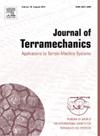The field of terramechanics focuses largely on two types of simulation approaches. First, the classical semi-empirical methods that rely on empirically determined soil parameters and equations to calculate the soil reaction forces acting on a wheel, track or tool. One major drawback to these methods is that they are only valid under steady-state conditions. The more flexible modelling approaches are discrete or finite element methods (DEM, FEM) that discretize the soil into elements. These computationally demanding approaches do away with the steady state assumption at the cost of including more model parameters that can be difficult to accurately tune. Model-free approaches in which machine learning algorithms are used to predict soil reaction forces have been explored in the past, but the use of these models comes at the cost of the valuable insight that the semi-empirical models provide. In this work, we presume that in a dynamic simulation, the soil reaction forces can be divided into a steady state component that can be captured using semi-empirical models and a dynamic component that cannot. We propose an augmented modelling approach in which a neural network is trained to predict the dynamic component of the reaction forces. We explore how this theory can be applied to the simulation of a soil-cutting blade using the Fundamental Earthmoving Equation and of a wheel driving over soft soil using the Bekker wheel-soil model.


